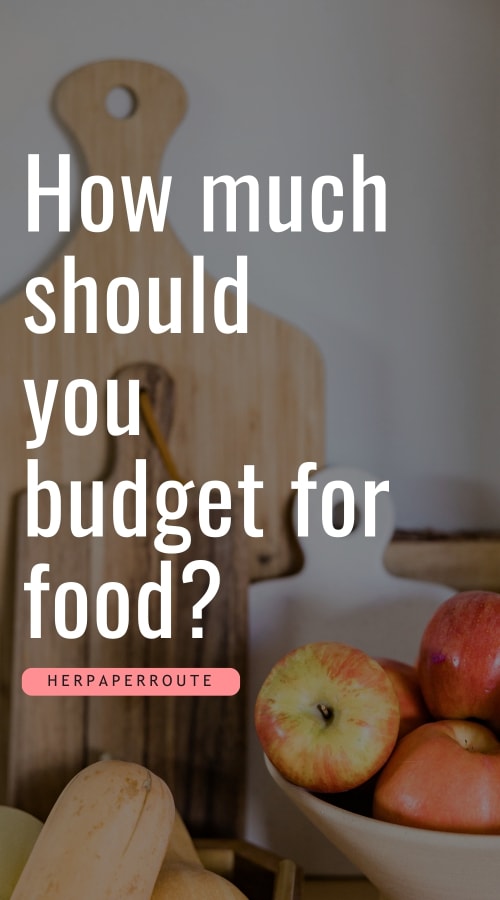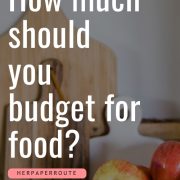How Much Should I Budget For Food?
No matter whether you’re single or part of a couple or family, a common question I get is what is the typical amount of money to spend on groceries per week or per month?
This can vary based on your individual situation but some averages are a good starting point that I’ll share below. Don’t get too hung up on the numbers or worried about what’s right.
This is simply a good starting point that can be tailored to fit you and your family’s needs.
Average Food Budgets for Groceries Explained
What is a good budget for food?
As an affiliate partner of various brands and sponsored content, HerPaperRoute may earn commission on qualifying purchases. Disclaimer | Advertise With Us
If you’re starting out, you should budget around $150 per child and $250 for every adult each month for food.
This means that a couple should budget $500 per month and a family with four should budget an estimated $800 every month for food. This should be enough for groceries and eating out occasionally.
What percentage of my budget should I spend on food?
According to the USDA, the average American spends between 9-11% of their budget on food. This equates to an estimated 6% on groceries and 5% on eating out.
If you eat at home more often, you can significantly lower your dining out budget. This will save you money and make your overall food budget closer to 9%.
✅ To save even more money on groceries, use Ibotta to upload your grocery receipts and earn cash back.
How much should you budget for food according to Dave Ramsey?
According to Dave Ramsey’s website, he recommends that you budget between 10-15% total on food. This includes both making meals at home and dining out.
College Student Food Budget Example
The typical college student probably has absolutely no idea what they spent on food last month. The majority of them are unlikely to have a budget for food at all.
For a college student, spending money on food is probably one of the biggest expenses, after tuition, books, and board. If you’re living on campus you may be able to take part in a meal plan program.
Meal plans usually offer the most amount of food for the least amount of money if you’re open to eating at the dining hall. Dining halls are set up in a buffet style so you can keep going back for more food.
Colleges have lots of dining options. You may want to get coffee while studying at the cafe or eat a la carte options. Don’t feel like you have to restricted to only eating at the dining hall. Even purchasing a smaller meal plan that allows you to eat one large meal at the dining hall and other meals elsewhere can save you a lot of money.
For your supplemental meals or if you aren’t able to get a college meal plan, you can inexpensively make many meals in your dorm room.
How much should college students budget for food?
The average college student should budget $400 a month, or $100 a week, for food. This will give you the financial flexibility to dine at a variety of places on-campus as well as eating off campus for a few meals.
Food Budget For 1 Person
When making a food budget for a single person, you should assess your situation realistically. How many days will you actually cook in a week? Saying you will cook 7 days a week will most likely end up in wasted food.
If you buy enough groceries to cook 7 days a week, some of it will probably go bad. If friends invite you out to dinner on the weekend, you’ll probably want to go.
That leaves the food you bought for that day sitting around in your fridge, getting older by the second. Instead of trying to maximize your groceries, factor in some eating-out days into your budget so that way you’re not wasting food.
To keep from having to cook every day for lunch and dinner, make larger portions when you do cook. This way you’ll have leftovers to bring to work. Or you can enjoy your leftovers when you get home from work after an especially exhausting day.
How much should 1 person budget for food?
Depending on your local cost of living, the food budget for one should be around $400 a month. This is equivalent to $100 spent on food per week for a single person.
A Couple’s Food Budget
Making a food budget for two people starts taking advantage of having extra help in the kitchen. Unlike a solo cook, couples have someone else who can share meal prep duties with.
If money is tight or you’re working at paying off debt, you should be able to split the cooking duty 50/50 with your partner. This will keep you from ever having to eat out at a restaurant due to cooking fatigue.
Don’t forget to keep the romance alive in your relationship though. If dinner dates are an important part of keeping your relationship strong, budget in extra money for that. You can also do a dinner cooking class at home from YouTube if you really can’t afford the added cost of a restaurant.
How much should couples budget for food?
Couples should budget between $500 to $700 a month for food. This is around $150 per week on food for 2 people. When making a grocery budget for two, you don’t need to double the money amount of a single person’s grocery budget. When budgeting for a couple, you can save money buying larger packages of food that cost less per unit.
Family Food Budget Examples
Food budgets for families are going to depend on how many people are in the family. A family of four’s food budget should be significantly less than a family of eight’s.
The age of the kids and family members also will play a factor. A toddler won’t eat as much as a teenager, and so on. But if you’d like to look at averages, we can analyze the most current data.
How much should I budget per child for food?
According to the USDA, the average cost of raising a child to age 18 from birth is $233,610. Around 18% of that cost is for food which equals $42,049.80. This means that $194.68 per month is spent on food throughout the 18 years.
A lot of people eat out frequently and don’t live their life with any sort of budget so this estimation may be a little high. In fact, American’s food budget percentage compared to their income has been at a historic low. I’d estimate that people who budget spend closer to $150 per month per child on food.
How much should a family of four budget for food?
The Bureau of Labor and Statistics states that the average food budget for an American family is $7,729 per year. This breaks down to $644 on food per month.
If you use the budget numbers for two adults in the couple’s section above, you’ll assume two adults can eat on $500/month or $250 each adult. Then factor in two kids at $150/month each. Your resulting food budget for a family of 4 is $800 per month.
So, how much should you budget for food for a family?
For a family’s food budget, a good rule of thumb is to factor $250 per month for each adult and $150 per month for each child. This is an estimate and could be more or less depending on the age of the kids and how much they eat.
Do you have an unrealistic food budget?
Often, we like to think that we spend less than we actually do. Tracking your food expenses for two months will give you a realistic overview of your food spending.
Knowing how much you’re actually spending vs what you think you’re spending can be quite the wake-up call. But it’s important not to swing towards the side of too restrictive.
It’s not likely that a family of four will be able to spend $250 a month total on food. Trying to force your family’s food budget to be too restrictive is only going to create unnecessary stress. Instead, try out some of the options I list below about saving money grocery shopping.

How To Save Money On Food Shopping
Now I want to go over ways you can save money on your groceries. If you have a large family or simply don’t earn a lot, you may be looking for ways to save significantly.
You may be asking yourself how do you grocery shop on a very tight budget? By following the tips below, you’ll save the most money on your grocery shopping trips.
1. Grocery Shop After Eating
Grocery shopping on a full stomach has been shown to increase spending on foods. Hunger has even been shown to increase the purchasing of non-food items. So if your grocery store has sections with kitchen goods or office supplies, you’re more likely to buy those too.
Hunger is a biological process that makes you search for food to eat. If you’re in a grocery shopping during this time, your options are plentiful and it can be hard to resist loading up your cart with impulse purchases.
So before you head to the store, make sure you’ve eaten a meal and are full. Even adding one or two extra items can push you over budget.
2. Couponing
Everyone knows that couponing saves money but only if it’s for items you were going to buy anyway. There’s no point in buying food you don’t normally eat just because it’s on sale.
There are a few places you can find coupons. Obviously the weekly flyers in the paper are a good source.
Lots of grocery store coupon apps have popped up the past few years. How they work is you check the apps for deals and coupons. Then after you checkout, you upload a copy of the grocery store receipt to the app for instant savings.
After you reach the payment threshold, you can cash out your earnings or use them to get gift cards. What’s even better is that you can use the same receipt for multiple apps. There’s no limit on how many different apps you can upload the receipt.
These apps aren’t only for groceries either. You can save money on many of your regular store purchases as well.
3. Make A List
Making and sticking to a grocery list will keep you from overbuying. There is a lot of research and market testing that goes into a field called supermarket psychology.
Everything, from the aisles, end caps, and even how large grocery carts are, has been tested and designed to elicit maximum sales. Even unhealthy sugary cereal has had boxes designed to market towards kids.
By making a list and having the willpower to stick to that list, you’re essentially putting on blinders to the billions of dollars that companies have spent to try to get you to buy more.
Another way to cut down on being tempted to buy extra while shopping is to order from a service like Instacart. You give them your grocery list and they’ll do the shopping and delivery for you. While there is a small cost for this service, the savings are recuperated in the amount of time you save and impulse purchases you avoid.
4. Meal Plan
Making a meal plan helps save money in a few ways. First, you’re only buying the food you need to make meals. Second, you have planned out your meals for the week so there’s no excuse to buy takeout.
After you get into the swing of things, meal planning can be down in an hour on the weekend. Then you just need to purchase the ingredients for those meals before the week starts.
5. Shop Weekly Sales Fliers
Every week grocery stores send out fliers with their sales and deals. Some of the fliers even have coupons you can use on top of the deals.
If you’re meal planning, you can plan your meals only using food thats on sale in the fliers. If potatoes are on sale one week, you can make an entire week’s worth of meals around potatoes in various forms.
Or pair food that’s on sale with other cheap foods.
6. Make Freezer Meals
Freezer meals are simply meals you make ahead of time that you place in the freezer for later. These are great for postpartum moms to have meals after baby is born to keep from ordering nightly takeout.
Freezer meals are also good to have on hand for the times your meal plans fall through. The easiest way to make them is to double your normal recipe. Then save the extra in a freezer-safe dish.
7. Buy In Bulk
Buying in bulk is a great way to save money but it only works if you use up the food. Bulk foods cost less per unit price but may not be practical for a single person or even a couple depending on how large a package it is.
Buying fresh produce and perishables in bulk makes even less sense unless you have a family. Another option would be to buy bulk for parties or if making dishes for a potluck.
If you don’t have a membership to a warehouse store like Costco, most stores allow one-day trial memberships for you to go in and check it out. Another option is to go with a friend who has a membership and pay them back after.
8. Choose Generic Brands
Generic grocery store brands are just as good or even the same as name brands. In many cases, they come from the exact same factory.
If a generic brand has the same ingredients as a more expensive name brand, that’s an easy switch to save money. Not all things are made equal but for basic foods, the generic store brand most likely tastes the same.
9. Only Get Certain Produce Organic
If you prefer to eat organic produce to reduce pesticide exposure or for environmental reasons, it can get expensive. A good rule of thumb is to buy the organic version if you will be eating the skin. This includes produce like apples, berries, and potatoes.
For produce where you remove the skin, the risk of pesticide ingestion goes down dramatically. This includes avocados, bananas, and citrus.
Is it cheaper to eat at home or out?
It is almost always cheaper to eat at home rather than going out to a restaurant. When making food at home, you’re not paying for wait staff and other overhead costs that a restaurant has to factor into their food prices.

Debunking the “I never have time to cook” Argument
You’ve probably told yourself more than once “I don’t have time to cook.”
People’s lives are becoming busier and busier and cooking is one of the tasks that tends to fall on the wayside. I wanted to put some things into perspective so that you can see how everyone has the time to prepare meals at home.
Cooking vs Takeout Time Breakdown
If you order food for takeout or pickup, your food will typically be ready in 15-20 minutes. If you’re picking up the food yourself, you’ll have to drive to the restaurant and back. This can be a 20-30 minute roundtrip excursion.
During this same time, you could’ve made a sandwich in less than 5 minutes. Another at-home option would’ve been to throw together a hearty salad using ingredients from your fridge and pantry. Both of these options require no real cooking necessary and are healthy.
For even more time savings, wash and chop up vegetables once a week and store them in your fridge. Then for salads, everything is already prepared.
Recent studies have shown that adults spend over 3 hours on their phones every day! By reallocating a half-hour of your previous phone time towards cooking and meal prep, you’ll have more than enough time to cook at home.
Is it a good idea to start meal planning?
Yes, you should start meal planning even if it’s a basic outline. Meal planning is one of the easiest ways to save money every month.
By having a general idea of meals for the week, you’ll be less likely to order food to-go or head to a restaurant. Your planned meals don’t need to be elaborate either, getting fixings for sandwiches is quick, inexpensive option.
How Much Should I Budget For Food – Conclusion
Everyone’s food budget and situation will be different. By understanding what the averages should be, you’ll have a great starting point when making your own food budget.
While you may not want to use all of the methods I mentioned for saving money on food, by incorporating one or two into your grocery shopping routine, you’ll still be able to recuperate significant savings.
Do you have a monthly food budget? Let me know how much it is in the comments below along with any food savings tips.
Related:
- 11 Ways to Beat Lifestyle Inflation
- Is Being Debt-Free the New Rich?
- 14 Money Blocks that are Keeping You Poor
- 100 Rich Mindset Quotes to Motivate You












